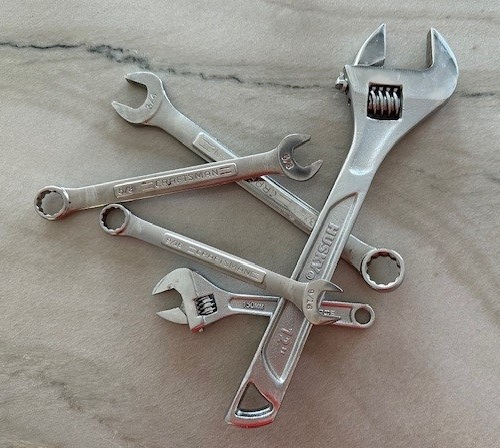A wrench, also known as a spanner, is a hand tool used for gripping, fastening, turning, or tightening objects, typically nuts and bolts. It comes in various shapes and sizes, each designed for specific tasks. Wrenches are essential tools in automotive repair, plumbing, construction, and many DIY projects, providing the necessary leverage to apply torque and loosen or tighten fasteners.
History of the Wrench
The wrench’s origins date back to the early 19th century, with various designs and types evolving over time to meet different needs. The first patent for a wrench was granted in 1835 to Solymon Merrick, who invented the adjustable wrench. As industrialization progressed, the need for more specialized wrenches arose, leading to the development of different types, such as pipe wrenches, socket wrenches, and ratcheting wrenches. Today, wrenches are indispensable in various industries, continuing to evolve with advancements in materials and design.
Types of Wrenches
- Adjustable Wrench
- Open-End Wrench
- Box-End Wrench
- Combination Wrench
- Socket Wrench
- Torque Wrench
- Pipe Wrench
- Ratcheting Wrench
- Allen Wrench (Hex Key)
- Crowfoot Wrench
- Basin Wrench
- Strap Wrench
Wrench Key Features
- Material: Typically made from hardened steel, sometimes with chrome or nickel plating for corrosion resistance.
- Handle Design: Ergonomic handles for comfort and enhanced grip.
- Jaw Size: Varies depending on the type, with adjustable options for versatility.
- Torque Capacity: Different wrenches are designed to handle varying amounts of torque.
- Size and Portability: Available in different sizes, with some being more compact and portable.
Choosing the Right Wrench
Selecting the appropriate wrench depends on the specific task at hand. For general purposes, a combination wrench or an adjustable wrench might suffice. However, for precision work, such as tightening bolts to a specific torque, a torque wrench is essential. It’s also crucial to consider the material and size of the fastener, as using the wrong wrench can damage the tool or the fastener. Having a set of wrenches in various sizes ensures that you’re prepared for any job.
Recommendations
Proper Use and Techniques
Using a wrench correctly involves selecting the right size and type, ensuring a snug fit on the fastener to avoid slipping or rounding off edges. Apply steady pressure, avoiding sudden jerks or excessive force. For tight spaces, a ratcheting wrench or a socket wrench with an extension can be more effective. Always pull the wrench towards you when possible to reduce the risk of injury.
Maintenance and Care
To keep your wrenches in good working condition, clean them after each use, especially if exposed to dirt, grease, or chemicals. Store them in a dry place to prevent rust, and consider using a wrench organizer to keep them orderly and accessible. Periodically check for any wear or damage, and replace any wrenches that are bent or have worn jaws.
Wrench Safety Tips
When using a wrench, always ensure that you have a firm grip and that the wrench is properly seated on the fastener. Wear gloves to protect your hands and safety glasses to shield your eyes from potential debris. Avoid using cheater bars or other extensions that can apply excessive torque, leading to tool failure or injury. Ensure that the work area is well-lit and clear of obstructions.
Conclusion
Wrenches are versatile and essential tools for any DIY enthusiast or professional. By understanding the different types, choosing the right one for the job, and using them correctly, you can ensure successful and safe project outcomes. Regular maintenance and adherence to safety practices will keep your wrenches in top condition, ready for any task.


